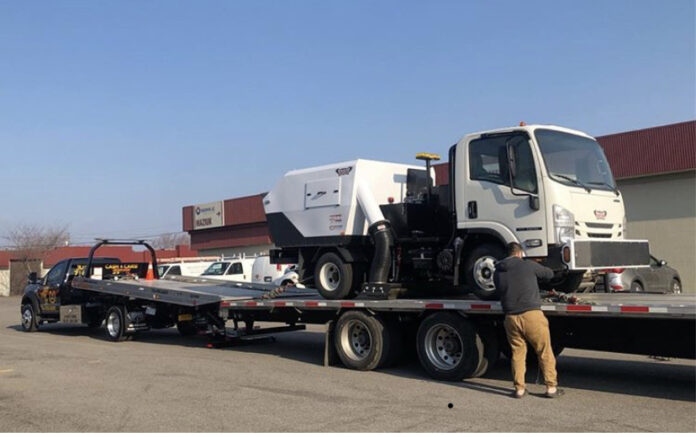Flatbed tow truck
A flatbed tow truck is a vehicle with an adjustable suspension and lift system that can be attached to the bed of the car to carry cars. The trucks operate in auto shops, garages, or parking enforcement (towing illegally parked autos).
Tow trucks come in many different sizes. However, most tow trucks are generally standard pick-ups with winches mounted to their beds and use various strapping mechanisms for flat-towing automobiles. Flatbeds typically cannot hoist vehicles nearly as high off the ground as traditional wreckers (unless they have a self-leveling suspension) and thus take up less room at accident scenes; however, some newer models allow for this but do not require extensive modification to the truck itself.
When to use flatbed tow trucks?
As we’ve said earlier, many customers prefer to have their car towed on a flatbed rather than any other kind of tow truck. There are many reasons for this, but the most usual is that they want to drive their car on a flatbed and avoid any damage. It may look simple, but it takes special training and skills to tow a vehicle on a flatbed. You can’t just attach straps and pull, you have to be careful not only with your safety but also with the safety of others around you.
There are some occasions when a flatbed tow truck is the only kind of tow truck that should be used. These include:
- When the car is being towed long distances, this can avoid any damage to the car.
- When the car is being towed on a public highway.
- When there is a risk of damage to the car if it is towed using another type of tow truck.
- When the car has been in an accident and needs to be transported to a garage or other location for repairs.
Flatbed tow trucks vs. wheel lift tow trucks
When you need to have your car towed, you will usually have a choice between a flatbed tow truck and a wheel lift tow truck. The two types of tow trucks are different in how they carry the car because flatbed tow trucks carry cars on their beds while wheel lift tow trucks carry cars via a mechanism that fits under them.
Both types of tow trucks have advantages and disadvantages. On the one hand, wheel lift tow trucks are more miniature than flatbeds, making it easier for them to go into places where larger vehicles cannot reach. They are generally lighter, too, so you could argue that they are more maneuverable around town.
On the other hand, flatbed tow trucks can travel faster and over longer distances without causing any damage to the car being towed because they take the whole vehicle on its bed rather than just its tires or chassis. There is also the minor change of the vehicle slipping off the bed.
Advantages of flatbed tow trucks
Flatbeds are more beneficial to use when flat-towing vehicles for the following reasons.
- It reduces the risk of damage to towed vehicles caused by onboard jacks on wreckers that are not adequately designed or positioned.
- Because there is no apparatus protruding from the back, it does not obstruct vision while driving.
- Flatbeds have a wider wheelbase than traditional wreckers allowing them to tow greater weights with less strain on their axles.
- They do not require extensive modification to the truck itself, so they maintain the excellent resale value and can often still operate as standard pick-up trucks.
- It is much easier to work on a vehicle while it’s flat on the back of the truck compared to the raised wreckers.
Disadvantages of flatbed tow trucks
Flatbeds have some disadvantages as well:
- Flatbeds tow with only two wheels, instead of four like regular tow trucks, and because they do not use heavy-duty suspension components, they cannot handle large weights or off-road conditions.
- The lack of an elevated bed limits their ability to transport vehicles that are too high for other types of tow trucks or loading docks, though newer models vary in this aspect.
- In many places where cars are towed, there is a weight limit on the tow truck that is lower than the weight of the car being towed. This necessitates using a regular tow truck for heavier vehicles, negating some of the flatbeds’ advantages over wreckers.
Conclusion
Read More: What Is Hot Shot Trucking And Everything You Need to Know About Hot shot Requirements
In conclusion, flatbed tow trucks offer several benefits over traditional wreckers, including minor damage to towed vehicles, ease of use, and reduced obstruction while driving. However, they also have some disadvantages: their limited ability to haul large weights and navigate rugged terrain. Ultimately, choosing between a flatbed and a regular tow truck depends on the situation’s specific needs.
FAQs
The maximum distance a car can be towed on a flatbed truck depends on the weight of the car and the size of the car. Generally, it is safe to tow a car for up to 100 miles.
A flatbed tow truck cannot tow buses because they are too large and heavy. However, there are specialized buses that are designed specifically for towing.
Wheel lift tow trucks carry cars via a mechanism that fits under them, while flatbed tow trucks take the whole vehicle on their bed. Wheel lift tow trucks are generally smaller and lighter than flatbeds, making them more maneuverable around town.
Flatbeds have a wider wheelbase than traditional wreckers, allowing them to tow greater weights with less strain on their axles. They also do not require extensive modification to the truck itself, making them more versatile.
There are several reasons why using a flatbed tow truck is beneficial. Flatbeds reduce the risk of damage to towed vehicles, they do not obstruct vision while driving, they have a wider wheelbase than regular tow trucks allowing them to drag greater weights, and they are much easier to work on a vehicle. At the same time, it is flat on the back of the truck.

















